|
|
SEAT Leon
Debut: 2005
Maker: SEAT
Predecessor: Leon Mk1 |
|
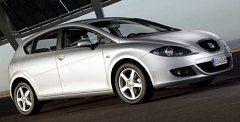 The
Golf
family is increasingly overcrowded. Volkswagen has 3 models built
directly
on the Golf V platform (Golf, Golf Plus and Touran), Audi has 2 (A3
and the next TT), Skoda has one (Octavia) and Seat has 3 (Altea,
Toledo and Leon). As they all share the same wheelbase and fall into
the same segment, how to diversify them is a big headache. Implement
that sensibly, the group will sell 2 million cars annually at
relatively little cost. Do that inadequately, the cars will steal
sales from each other, hurting profit as well as the relationship
between divisions. The
Golf
family is increasingly overcrowded. Volkswagen has 3 models built
directly
on the Golf V platform (Golf, Golf Plus and Touran), Audi has 2 (A3
and the next TT), Skoda has one (Octavia) and Seat has 3 (Altea,
Toledo and Leon). As they all share the same wheelbase and fall into
the same segment, how to diversify them is a big headache. Implement
that sensibly, the group will sell 2 million cars annually at
relatively little cost. Do that inadequately, the cars will steal
sales from each other, hurting profit as well as the relationship
between divisions.
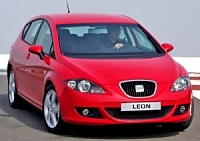 This
problem is especially serious at Seat. Buyers will find it difficult
to choose among Leon, Altea and Toledo. Basically, they have the same
underpinnings and the same design language. In theory, they can be
distinguished in this way: Leon is the normal family hatch, Altea is
the MAV (Renault Scenic alike) while Toledo is a sedan with a big
boot. In reality, however, the Altea is never spacious or versatile
enough to be a real MAV, while the Toledo's tiny boot is actually a
hatchback. Therefore both actually competes with Leon in the family
hatch segment. This
problem is especially serious at Seat. Buyers will find it difficult
to choose among Leon, Altea and Toledo. Basically, they have the same
underpinnings and the same design language. In theory, they can be
distinguished in this way: Leon is the normal family hatch, Altea is
the MAV (Renault Scenic alike) while Toledo is a sedan with a big
boot. In reality, however, the Altea is never spacious or versatile
enough to be a real MAV, while the Toledo's tiny boot is actually a
hatchback. Therefore both actually competes with Leon in the family
hatch segment.
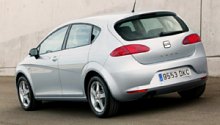 However,
Leon is likely to be a winner in this internal competition. The
design language of Walter de Silva works best in this hatchback,
whose roof is 110 mm lower than Altea's. This allows the sweeping,
flowing lines to wrap the body smoothly and tautly, delivering a more
aggressive feel than its sisters. In fact, Leon is the direct
evolution from de Silva's beautiful 2002 concept car Salsa. However,
Leon is likely to be a winner in this internal competition. The
design language of Walter de Silva works best in this hatchback,
whose roof is 110 mm lower than Altea's. This allows the sweeping,
flowing lines to wrap the body smoothly and tautly, delivering a more
aggressive feel than its sisters. In fact, Leon is the direct
evolution from de Silva's beautiful 2002 concept car Salsa.
The Leon
also employs de Silva's signature "hidden" rear door
handles, just like his Alfa Romeo 156. The handles locate at the
trailing edge of the rear window. Once you open the doors, you will
see a minimalist interior like its sister cars. Although the
materials and build quality are average by today's standard, the
simple dashboard and console are driver-oriented and initiative to
use. The cabin is roomy and the boot has the right size (341 litres),
so no complaint here.
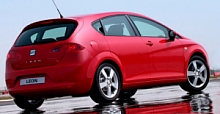 Mechanically,
I hope you don't need me to repeat those I said for Volkswagen Golf
etc. In short, it employs a sophisticated multi-link rear suspensions
that French rivals will envy. Predictably, Seat is the sporty and
emotional interpretation of Volkswagen, thus Leon gets slightly
harder suspensions to lift handling. Inevitably, there is some
trade-off in ride comfort and quietness. Compare with Altea and
Toledo, Leon is of course better to drive, thanks to the lower center
of gravity. Mechanically,
I hope you don't need me to repeat those I said for Volkswagen Golf
etc. In short, it employs a sophisticated multi-link rear suspensions
that French rivals will envy. Predictably, Seat is the sporty and
emotional interpretation of Volkswagen, thus Leon gets slightly
harder suspensions to lift handling. Inevitably, there is some
trade-off in ride comfort and quietness. Compare with Altea and
Toledo, Leon is of course better to drive, thanks to the lower center
of gravity.
 Most
Leon
will be sold with the regular engines shared with its sister cars -
102 hp 1.6, 150 hp 2.0FSI, 105hp 1.9TDI and 140hp 2.0TDI 16V.
However, what really interesting is the sporty Leons. In the last
generations, they had a 1.8 turbo engine with 3 stages of tune
(150hp, 180hp and 210hp for Cupra R, the latter eventually lifted to
225hp). In the new car, the 1.8T engine is replaced by Volkswagen's
new all-alloy, 2.0TFSI turbo engine. It appears in 3 forms: 185hp for
the base engine,
200hp for FR and 240hp for the Cupra equipped with 4WD. The difference
lies mainly in engine management program,
turbocharger and intercoolers. At the moment, only the 185hp version
is available, but Volkswagen Golf has already proved that the
front-drive chassis is capable to handle the 200hp engine. Most
Leon
will be sold with the regular engines shared with its sister cars -
102 hp 1.6, 150 hp 2.0FSI, 105hp 1.9TDI and 140hp 2.0TDI 16V.
However, what really interesting is the sporty Leons. In the last
generations, they had a 1.8 turbo engine with 3 stages of tune
(150hp, 180hp and 210hp for Cupra R, the latter eventually lifted to
225hp). In the new car, the 1.8T engine is replaced by Volkswagen's
new all-alloy, 2.0TFSI turbo engine. It appears in 3 forms: 185hp for
the base engine,
200hp for FR and 240hp for the Cupra equipped with 4WD. The difference
lies mainly in engine management program,
turbocharger and intercoolers. At the moment, only the 185hp version
is available, but Volkswagen Golf has already proved that the
front-drive chassis is capable to handle the 200hp engine.
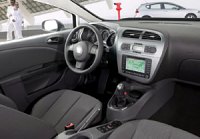 The 185
horsepower engine produces the maximum 199 lbft of torque from just
1800 rpm all the way to 5500 rpm, therefore performance is easily
accessible, especially when the engine is mated with the
slick-shifting 6-speed manual gearbox. DSG is also a superb gearbox,
but it is perhaps too costly to the buyers of Seat. The 185 hp Leon
is expected to do 0-60 in 7.4 seconds, which means very good
performance for money. For the same money, you can get only a Golf
2.0 FSI with 150hp and 147lbft, 0-60 in 8.6 sec. The 185
horsepower engine produces the maximum 199 lbft of torque from just
1800 rpm all the way to 5500 rpm, therefore performance is easily
accessible, especially when the engine is mated with the
slick-shifting 6-speed manual gearbox. DSG is also a superb gearbox,
but it is perhaps too costly to the buyers of Seat. The 185 hp Leon
is expected to do 0-60 in 7.4 seconds, which means very good
performance for money. For the same money, you can get only a Golf
2.0 FSI with 150hp and 147lbft, 0-60 in 8.6 sec.
Seat Leon
is high on styling, handling, performance and value for money. If you
are prepared to sacrifice some ride refinement and put up with the
Spartan interior, it could be your everyday dreamcar. It might not
appeal to the majority drivers, but keen drivers will definitely like
it.
|
| The
above report was last updated on 30 June 2005. All Rights Reserved. |
|
Leon Cupra
|
 The
project managers of Opel Astra OPC, Ford Focus ST and Renault Sport
Megane R26 must be jealous of their counterpart at Seat, because Seat
Leon Cupra has so many inherent advantages. Firstly, the base Leon is
already the best-looking hatchback in the class. Give it some
aerodynamic kits and 18-inch alloy wheels alone will easily make the
most visually attractive hot hatch in the world. It makes the OPC looks
too aftermarket, the R26 too weird and the ST too ugly. And you know, a
good look is a must for a successful hot hatch. The
project managers of Opel Astra OPC, Ford Focus ST and Renault Sport
Megane R26 must be jealous of their counterpart at Seat, because Seat
Leon Cupra has so many inherent advantages. Firstly, the base Leon is
already the best-looking hatchback in the class. Give it some
aerodynamic kits and 18-inch alloy wheels alone will easily make the
most visually attractive hot hatch in the world. It makes the OPC looks
too aftermarket, the R26 too weird and the ST too ugly. And you know, a
good look is a must for a successful hot hatch.
Then its rivals may also
jealous the good mechanicals available from Volkswagen group's parts
pool, such as the sophisticated 2.0 TFSI engine with all-aluminum
construction, twin-balancer shafts, direct injection and full
continuous variable valve timing. Oh, and don't forget the turbocharger
now boosts power to 240hp. While Opel's similar 2.0 turbo engine needs
to overwork to deliver the same power - hence producing old-fashion
turbo lag, the Volkswagen powerplant is so much more linear and
tractable. As much as 221 lbft of torque is available from 2200-5500
rpm. There's a touch more turbo lag than the 200hp version, but still
surprisingly well tamed. With this superb engine, Leon Cupra can sprint
from zero to sixty mph in 6.1 seconds and top 153 mph. That's about the
most you can ask for a front-drive hatchback.
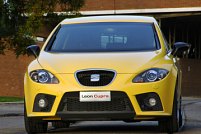 Apart from engine,
Volkswagen also supplies a fabulous 6-speed manual gearbox - although
DSG is not offered. 6 closely stacked ratios mate with a slick
gearchange means it is a joy to use. Apart from engine,
Volkswagen also supplies a fabulous 6-speed manual gearbox - although
DSG is not offered. 6 closely stacked ratios mate with a slick
gearchange means it is a joy to use.
The Golf V platform
underpinning the Seat is another source of jealousy. MacPherson struts
up front and expensive multi-link suspensions at the rear. Now the
Cupra also exchanges the steel steering knuckles and rear wishbones
with items made of lightweight aluminum. As a result, unsprung weight
is largely reduced and softer spring setup can be adopted (compare with
the 200hp Leon FR) to improve ride quality. On the road, the Cupra
rides compliantly, if not as brilliant as Golf GTI or Focus ST. Body
roll is well checked. Grip is never in doubt. The chassis is free of
torque steer, something OPC must be jealous. As for braking, the huge
345mm front discs provides powerful, fade-free and progressive
stopping, even before the optional Brembo calipers are ticked.
 Unfortunately, despite of
all these good hardwares, the Cupra is short of driver involvement. Its
electro-mechanical steering is almost lifeless; Its chassis is
reluctant to throttle steer. From driver's point of view, the Cupra is
a capable but uncommunicative driving machine. It is not as inspiring
as Golf GTI or Megane R26, nor as thrilling as the raw Astra OPC.
Strangely, the chassis and steering are basically the same as its Golf
cousin, so the difference in real world is down to the fine tuning. Unfortunately, despite of
all these good hardwares, the Cupra is short of driver involvement. Its
electro-mechanical steering is almost lifeless; Its chassis is
reluctant to throttle steer. From driver's point of view, the Cupra is
a capable but uncommunicative driving machine. It is not as inspiring
as Golf GTI or Megane R26, nor as thrilling as the raw Astra OPC.
Strangely, the chassis and steering are basically the same as its Golf
cousin, so the difference in real world is down to the fine tuning.
What
a pity, a first rate package is let down by an inadequate tuning. When
it comes to chassis tuning engineers, other car makers have nothing to
jealous of Seat.
|
| The
above report was last updated on 1 Jan 2007. All Rights Reserved. |
|
Leon Cupra R
|

|
Hottest Leon is 20 percent cheaper
than its premium siblings sharing the same heart...
|
What do SEAT Leon Cupra R,
Audi S3 and Volkswagen Scirocco R have in common ? The answer is their
engine. Compared with lesser 2.0TFSI engine, their version has higher
turbo boost (1.2 bar), larger intercooler and higher pressure direct
injection to achieve 265 horsepower at 6000 rpm and 258 lb-ft of torque
from 2500 to 5000 rpm. On the one hand they can complete 0-60 sprint in
less than 6 seconds and top an electronically regulated 155 mph. On the
other hand their power delivery is linear and free-revving.
These merits make the Spanish car all the more attractive. Think about
it,
priced at £23,000, it is nearly 20 percent cheaper than its
premium alternatives. Is it really that good ?
Dig deeper into the car, you will find it lacks the premium build
quality of its siblings. Also lacking is a sense of occasion normally
associated with a top-of-the-range model. This is quite strange. While
SEAT deliberately styled the top Ibiza more aggressively than lesser
models, it did too little to lift Leon Cupra R above the 240-horsepower
Cupra. In fact, apart from larger wheels and three additional
openings around its nose intake, we can hardly find any differences
from the lesser model. If you prefer big spoilers and pronounced
wheelarches, I suggest you should look at Ford Focus RS or Subaru
Impreza STI. If you prefer a creative design, Scirocco R or the new
Renaultsport Megane will be far better choice. Leon is still stylish,
but in Cupra R form it is nothing special.

|
It hates the B-roads where Scirocco R
and Focus RS shine...
|
Apart from style, picky journalists
could also criticize its short of extra performance over the already
quick Cupra. Read the spec table below, you will find its 25 additional
horsepower brings an improvement of only a couple of mph and a couple
of
tenths for 0-60 mph. The R doesn't seem really R. On the road, its
performance matches that of Renaultsport
and Scirocco, but what about Focus RS, which offers an extra 40 horses
and 66 lb-ft ? No match.
On the plus side, the relatively modest power leads to virtually no
torque
steer. This make the XDS electronic pseudo differential more than
capable to lay down its power
effectively from the front wheels to the road. That's not a surprise,
because the new Golf GTI and Scirocco also have this feature equipped.
The Cupra R rides on very stiff suspensions and aggressive tires
(235/35ZR19). Compare with Cupra its front and rear springs are
stiffened
by 35 and 30 percent respectively. It also lacks the sophisticated
adaptive dampers that Scirocco R has. This mean it hates
the B-roads where Scirocco R and Focus RS shine. In return, it shows
excellent cornering stability and grip. Pizza-size brake discs
(measuring 345mm front and 286mm rear) provides strong stopping power.
The chassis is tuned to allow some lift-off oversteer to delight
enthusiastic drivers. What a pity its ESP cannot be fully disabled.
Moreover, the steering is too light to inspire confidence. Overall, its
handling and ride gives a mixed impression. The best aspect of Cupra R
is still its elastic power delivery. That is not enough to make an
outstanding hot hatch.
|
| The
above report was last updated on 4 Nov 2009. All Rights Reserved. |
| Specifications
|
| General remarks |
| Layout |
| Chassis |
| Body |
| Length / width / height |
| Wheelbase |
| Engine |
| Capacity |
| Valve gears |
| Induction |
| Other engine features |
| Max power |
| Max torque |
| Transmission |
Suspension layout
|
| Suspension features |
| Tires |
| Kerb weight |
| Top speed |
| 0-60 mph (sec) |
| 0-100 mph (sec) |
|
| Leon 1.6 |
Front-engined, FWD
|
| Steel monocoque |
| Mainly steel |
| 4315 / 1768 / 1458 mm |
| 2578 mm |
| Inline-4 |
| 1595 cc |
| SOHC 16 valves |
| - |
| - |
102 hp
|
109 lbft
|
| 5-speed manual |
F: strut
R: multi-link
|
| - |
| 205/55VR16 |
| 1205 kg |
| 114 mph (c) |
| 11.0 (c) |
| - |
|
| Leon 2.0TFSI |
Front-engined, FWD
|
| Steel monocoque |
| Mainly steel |
| 4315 / 1768 / 1458 mm |
| 2578 mm |
| Inline-4 |
| 1984 cc |
DOHC 16 valves, VVT
|
Turbo, VIM
|
| DI |
185 hp
|
199 lbft
|
| 6-speed manual |
F: strut
R: multi-link
|
| - |
| 225/45WR17 |
| 1334 kg |
| 137 mph (c) |
| 7.4 (c) |
| - |
|
| Leon Cupra |
Front-engined, FWD
|
| Steel monocoque |
| Mainly steel |
| 4323 / 1768 / 1446 mm |
| 2578 mm |
| Inline-4 |
| 1984 cc |
DOHC 16 valves, VVT
|
Turbo, VIM
|
| DI |
240 hp
|
221 lbft
|
| 6-speed manual |
F: strut
R: multi-link
|
| - |
| 225/45ZR18 |
| 1334 kg |
| 153 mph (c) |
| 6.1 (c) |
| - |
|
|
|
|
|
| General remarks |
| Layout |
| Chassis |
| Body |
| Length / width / height |
| Wheelbase |
| Engine |
| Capacity |
| Valve gears |
| Induction |
| Other engine features |
| Max power |
| Max torque |
| Transmission |
Suspension layout
|
| Suspension features |
| Tires |
| Kerb weight |
| Top speed |
| 0-60 mph (sec) |
| 0-100 mph (sec) |
|
| Leon Cupra R |
Front-engined, FWD
|
| Steel monocoque |
| Mainly steel |
| 4309 / 1768 / 1443 mm |
| 2578 mm |
| Inline-4 |
| 1984 cc |
DOHC 16 valves, VVT
|
Turbo, VIM
|
| DI |
265 hp / 6000 rpm
|
258 lbft / 2500-5000 rpm
|
| 6-speed manual |
F: strut
R: multi-link
|
| - |
| 235/35ZR19 |
| 1375 kg |
| 155 mph (limited) |
| 5.9 (c) |
| - |
|
|
|
|
| Performance
tested by: - |
Copyright©
1997-2009
by Mark Wan @ AutoZine
|
|
|
 The
Golf
family is increasingly overcrowded. Volkswagen has 3 models built
directly
on the Golf V platform (Golf, Golf Plus and Touran), Audi has 2 (A3
and the next TT), Skoda has one (Octavia) and Seat has 3 (Altea,
Toledo and Leon). As they all share the same wheelbase and fall into
the same segment, how to diversify them is a big headache. Implement
that sensibly, the group will sell 2 million cars annually at
relatively little cost. Do that inadequately, the cars will steal
sales from each other, hurting profit as well as the relationship
between divisions.
The
Golf
family is increasingly overcrowded. Volkswagen has 3 models built
directly
on the Golf V platform (Golf, Golf Plus and Touran), Audi has 2 (A3
and the next TT), Skoda has one (Octavia) and Seat has 3 (Altea,
Toledo and Leon). As they all share the same wheelbase and fall into
the same segment, how to diversify them is a big headache. Implement
that sensibly, the group will sell 2 million cars annually at
relatively little cost. Do that inadequately, the cars will steal
sales from each other, hurting profit as well as the relationship
between divisions.  This
problem is especially serious at Seat. Buyers will find it difficult
to choose among Leon, Altea and Toledo. Basically, they have the same
underpinnings and the same design language. In theory, they can be
distinguished in this way: Leon is the normal family hatch, Altea is
the MAV (Renault Scenic alike) while Toledo is a sedan with a big
boot. In reality, however, the Altea is never spacious or versatile
enough to be a real MAV, while the Toledo's tiny boot is actually a
hatchback. Therefore both actually competes with Leon in the family
hatch segment.
This
problem is especially serious at Seat. Buyers will find it difficult
to choose among Leon, Altea and Toledo. Basically, they have the same
underpinnings and the same design language. In theory, they can be
distinguished in this way: Leon is the normal family hatch, Altea is
the MAV (Renault Scenic alike) while Toledo is a sedan with a big
boot. In reality, however, the Altea is never spacious or versatile
enough to be a real MAV, while the Toledo's tiny boot is actually a
hatchback. Therefore both actually competes with Leon in the family
hatch segment.  However,
Leon is likely to be a winner in this internal competition. The
design language of Walter de Silva works best in this hatchback,
whose roof is 110 mm lower than Altea's. This allows the sweeping,
flowing lines to wrap the body smoothly and tautly, delivering a more
aggressive feel than its sisters. In fact, Leon is the direct
evolution from de Silva's beautiful 2002 concept car Salsa.
However,
Leon is likely to be a winner in this internal competition. The
design language of Walter de Silva works best in this hatchback,
whose roof is 110 mm lower than Altea's. This allows the sweeping,
flowing lines to wrap the body smoothly and tautly, delivering a more
aggressive feel than its sisters. In fact, Leon is the direct
evolution from de Silva's beautiful 2002 concept car Salsa.  Mechanically,
I hope you don't need me to repeat those I said for Volkswagen Golf
etc. In short, it employs a sophisticated multi-link rear suspensions
that French rivals will envy. Predictably, Seat is the sporty and
emotional interpretation of Volkswagen, thus Leon gets slightly
harder suspensions to lift handling. Inevitably, there is some
trade-off in ride comfort and quietness. Compare with Altea and
Toledo, Leon is of course better to drive, thanks to the lower center
of gravity.
Mechanically,
I hope you don't need me to repeat those I said for Volkswagen Golf
etc. In short, it employs a sophisticated multi-link rear suspensions
that French rivals will envy. Predictably, Seat is the sporty and
emotional interpretation of Volkswagen, thus Leon gets slightly
harder suspensions to lift handling. Inevitably, there is some
trade-off in ride comfort and quietness. Compare with Altea and
Toledo, Leon is of course better to drive, thanks to the lower center
of gravity.  Most
Leon
will be sold with the regular engines shared with its sister cars -
102 hp 1.6, 150 hp 2.0FSI, 105hp 1.9TDI and 140hp 2.0TDI 16V.
However, what really interesting is the sporty Leons. In the last
generations, they had a 1.8 turbo engine with 3 stages of tune
(150hp, 180hp and 210hp for Cupra R, the latter eventually lifted to
225hp). In the new car, the 1.8T engine is replaced by Volkswagen's
new all-alloy, 2.0TFSI turbo engine. It appears in 3 forms: 185hp for
the base engine,
200hp for FR and 240hp for the Cupra equipped with 4WD. The difference
lies mainly in engine management program,
turbocharger and intercoolers. At the moment, only the 185hp version
is available, but Volkswagen Golf has already proved that the
front-drive chassis is capable to handle the 200hp engine.
Most
Leon
will be sold with the regular engines shared with its sister cars -
102 hp 1.6, 150 hp 2.0FSI, 105hp 1.9TDI and 140hp 2.0TDI 16V.
However, what really interesting is the sporty Leons. In the last
generations, they had a 1.8 turbo engine with 3 stages of tune
(150hp, 180hp and 210hp for Cupra R, the latter eventually lifted to
225hp). In the new car, the 1.8T engine is replaced by Volkswagen's
new all-alloy, 2.0TFSI turbo engine. It appears in 3 forms: 185hp for
the base engine,
200hp for FR and 240hp for the Cupra equipped with 4WD. The difference
lies mainly in engine management program,
turbocharger and intercoolers. At the moment, only the 185hp version
is available, but Volkswagen Golf has already proved that the
front-drive chassis is capable to handle the 200hp engine.  The 185
horsepower engine produces the maximum 199 lbft of torque from just
1800 rpm all the way to 5500 rpm, therefore performance is easily
accessible, especially when the engine is mated with the
slick-shifting 6-speed manual gearbox. DSG is also a superb gearbox,
but it is perhaps too costly to the buyers of Seat. The 185 hp Leon
is expected to do 0-60 in 7.4 seconds, which means very good
performance for money. For the same money, you can get only a Golf
2.0 FSI with 150hp and 147lbft, 0-60 in 8.6 sec.
The 185
horsepower engine produces the maximum 199 lbft of torque from just
1800 rpm all the way to 5500 rpm, therefore performance is easily
accessible, especially when the engine is mated with the
slick-shifting 6-speed manual gearbox. DSG is also a superb gearbox,
but it is perhaps too costly to the buyers of Seat. The 185 hp Leon
is expected to do 0-60 in 7.4 seconds, which means very good
performance for money. For the same money, you can get only a Golf
2.0 FSI with 150hp and 147lbft, 0-60 in 8.6 sec. 



